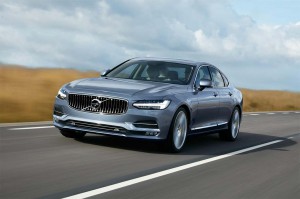
Volvo is offering semi-autonomous technology for the first time on its new S90 flagship sedan this year.
Volvo is poised to set an industry first. The Swedish maker plans to make its Driver Assist system standard when it launches the all-new Volvo S90 sedan later this year.
Self-driving technology has become one of the hottest topics in the auto industry, a variety of manufacturers outlining plans to eventually offer hands-free systems during this week’s Consumer Electronics Show in Las Vegas. A number of makers expect to begin rolling out semi-autonomous systems between now and the end of the decade, but Volvo is likely to become the first to make such technology standard on one model.
“We think it’s a great feature and see that (consumer) interest in this technology is increasing quite rapidly,” said Erik Coelingh, senior technical leader for Volvo’s active safety operations.
Tesla recently became the first to offer a semi-autonomous system, its new AutoPilot, offered as an option on both the Model S sedan and Model X SUV. AutoPilot allows hands-free operation on well-marked, limited-access roadways.
The Chinese-owned Volvo is taking a somewhat more conservative approach. It will allow a driver to take their hands off the wheel for no more than a half minute or so before advising the driver to take control again. Otherwise, the Driver Assist system will disengage.
But Coelingh contends that the technology will add a significant level of safety, nonetheless. Using a variety of camera and radar sensors to help the driver steer, slow, stop and then start back up again. He claims Pilot Assist not only can react to emergencies quicker than a human but also smooth out driving in traffic.
(Volvo lifts covers off new S90 flagship. For more, Click Here.)
Volvo first introduced Driver Assist as an option on its redesigned XC90 for the 2016 model-year. It will not only become standard on the new Volvo S90 flagship but will boost its top operating speed to 80 mph.
The roll-out is part of Volvo’s long-term goal in which “no one will be killed or critical engineered in a crash” in any Volvo vehicle built by 2020,” said Coelingh.
To get there, the carmaker is planning to steadily expand the capabilities of Driver Assist and then launch its fully autonomous Auto Pilot system. Right now, however, the technical leader said that fully hands-free systems just aren’t ready for retail use.
That said, a number of automakers are already testing fully hands-free prototypes, notably Silicon Valley tech giant Google. Ford Motor Co. announced at the Consumer Electronic Show that it will this year triple the size of its own autonomous test fleet.
(Click Here to check out the Volvo Concept 26.)
How fast various levels of autonomous technology will hit market is a matter of debate. Nissan has said it plans to put its first completely hands-free model into production by 2020. Korean carmaker Kia told a CES audience it will launch its semi-autonomous Drive Wise system in 2020 and, by 2030, hopes to have not only a fully hands-free system available but one capable of operating without a human backup behind the wheel.
Ride-sharing services like Uber and Lyft are looking at driverless vehicles as a way to both enhance safety and reduce operating costs.
Whether autonomous vehicles can meet the ambitious goal of eliminating highway crashes is also a matter of debate.
“Zero accidents will never happen,” argued Amnon Shashua, founder and CEO of Israeli-based Mobileye, which supplies camera-based technology to dozens of makers, and which recently announced a major deal with General Motors.
(Volvo planning to add plug-in hybrid options across its product range. Click Here for more.)
That said, Dr. Shashua said he believes autonomous technology eventually could reduce the number of U.S. highway fatalities by “three orders of magnitude,” which would bring fatalities down to around 300 a year, compared to more than 32,000 in 2014.

